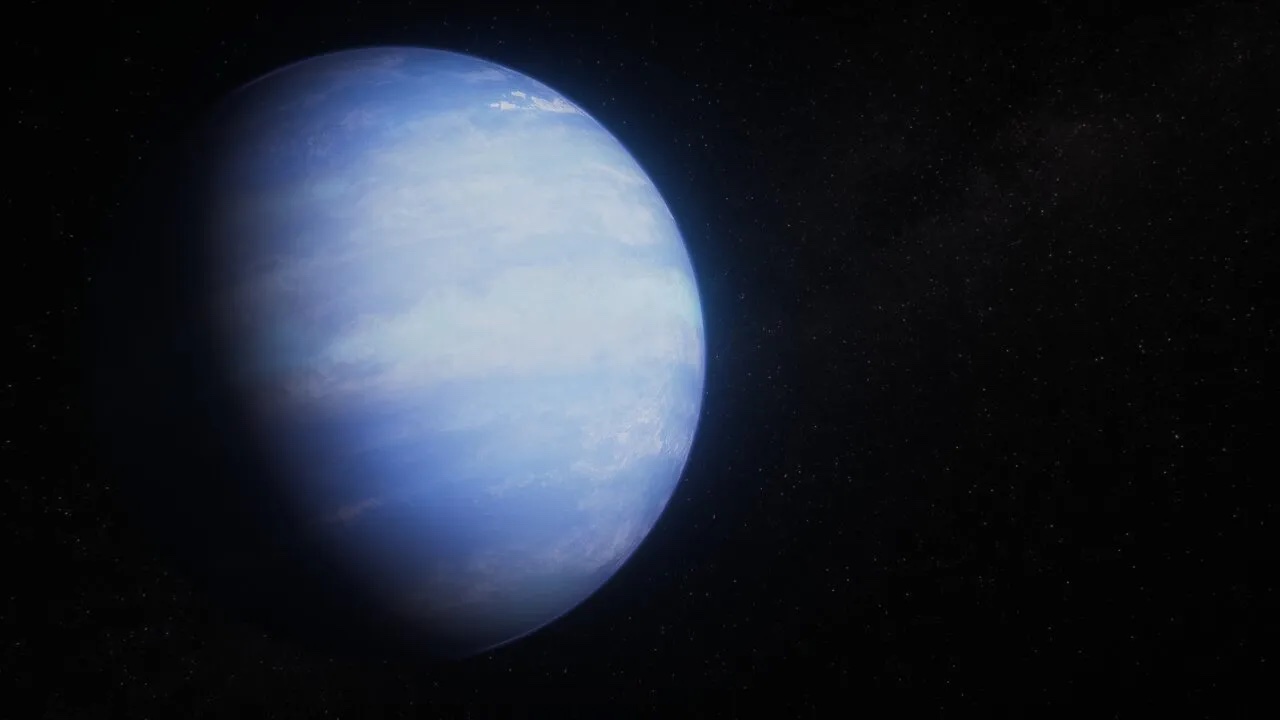Mysterious 'puffy' planet may finally be explained by James Webb Space Telescope
The exoplanet WASP-107 b is one of the least dense planets ever discovered. New James Webb telescope observations may reveal how the mysterious world got so 'puffy'.

A surprisingly low reservoir of methane may explain how a planet around a nearby star grew weirdly puffy, according to new observations from the James Webb Space Telescope (JWST). The finding shows that planetary atmospheres can inflate to remarkable amounts without employing esoteric theories of planet formation, astronomers say.
"The Webb data tells us that planets like WASP-107 b didn't have to form in some odd way with a super small core and a huge gassy envelope," Michael Line, an extrasolar planetologist at Arizona State University, said in a statement. "Instead, we can take something more like Neptune, with a lot of rock and not as much gas, just dial up the temperature, and poof it up to look the way it does."
Discovered in 2017 by the Wide Angle Search for Planets (WASP) consortium, WASP-107 b, located roughly 200 light-years from Earth in the constellation Virgo, is among the lightest of the more than 5,000 exoplanets found thus far. Despite being nearly as large as Jupiter, WASP-107 b weighs just 12%of the gas giant's mass, equivalent to only 30 Earths. For context, one Jupiter mass is equal to about 318 Earth masses. This planet is so puffy, the team says, that its density can be likened to a microwaved marshmallow.
From previous observations of WASP-107 b's size, mass and age, astronomers suspected the planet had a small, rocky core enveloped by a rich reservoir of hydrogen and helium gases. However, such a scenario failed to fully explain the remarkably bloated orb, which, despite the fact it orbits its star at one-seventh the distance between Mercury and our sun, doesn't receive enough energy from its star to account for its cotton-like density. Alternatively, if the planet's core actually held more mass than expected, scientists say the atmosphere would have shrunk as the planet cooled over time, meaning it would have turned out smaller than what is observed.
Now, using the JWST's data — combined with previous observations from the Hubble Space Telescope — two independent teams of astronomers may have solved the puzzle. In short, they discovered that methane in the planet's atmosphere is one-thousandth of what would be expected for this world. Because methane is unstable at high temperatures, astronomers say the surprisingly low amount is evidence that the gas from deep within the planet is "mixing vigorously with cooler layers higher up," David Sing of Johns Hopkins University (JHU) in Maryland, who led one of the two new studies, said in the statement. "The fact that we detected so little, even though we did detect other carbon-bearing molecules, tells us that the interior of the planet must be significantly hotter than we thought."
The extra heat likely comes from the fact that WASP-107 b zips around its star every 5.7 days in an orbit that is not a perfect circle, the researchers say. The star's constant gravitational pull on WASP-107 b, whose distance from its star keeps varying throughout, stretches and contracts the planet’s profile, thereby heating it up. On Earth, a similar force by the moon causes high and low tides.
Sign up for the Live Science daily newsletter now
Get the world’s most fascinating discoveries delivered straight to your inbox.
The planet's hot core combined with tidal heating from its star is also changing the chemistry of the gases deep within the planet, Zafar Rustamkulov, who is a graduate student at JHU and a co-author of one of the two new studies, said in a statement from the university. "We think this heat is causing the chemistry of the gases to change, specifically destroying methane and making elevated amounts of carbon dioxide and carbon monoxide."
In 2020, a team of astronomers, including Sing, detected helium in the atmosphere of WASP-107 b, marking the discovery as the first time this gas was spotted on an exoplanet. The element, which was tentatively spotted on the world in 2018 before having its existence there confirmed two years later, was seen extending far out into space as a tenuous cloud. Because this planet's atmosphere so far flung, astronomers say ultraviolet radiation from WASP-107 b’s star is slowly stripping the world of its air — about 0.1% to 4% of atmospheric mass every billion years, to be more specific, which results in a comet-like tail trailing behind the orb.
Thanks to the planet’s supremely puffy nature, astronomers can look about 50 times deeper into its atmosphere than they can for a world like Jupiter. Last year, for instance, JWST observations of WASP-107 b's atmosphere showed it rains sand on the planet.
This research is described in two studies published Monday (May 20) in the journal Nature.
Originally published on Space.com.

Sharmila Kuthunur is a Seattle-based science journalist focusing on astronomy and space exploration. Her work has also appeared in Scientific American, Astronomy and Space.com, among other publications. She has earned a master's degree in journalism from Northeastern University in Boston. Follow her on BlueSky @skuthunur.bsky.social










